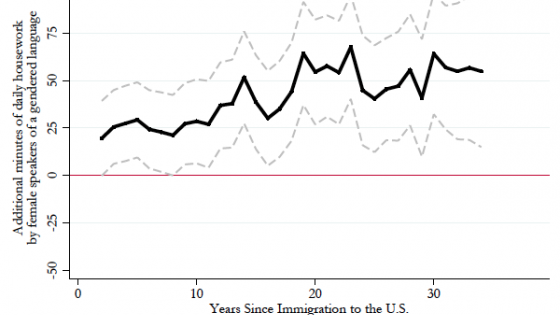Language influences our cognition and decision-making processes. Several studies have shown that linguistic factors can shape our behaviour. Speakers of languages that distinguish between the future and the present tend to save less, while bilingual individuals display different attitudes depending on the language they are using (Chen 2013, Ogunnaike et al. 2010, Danziger and Ward 2010).In particular, gendered language has been suggested to reinforce gendered divisions of labour, making them appear more natural (Whorf 1956). In English, the generic use of “he” has been found to evoke male images in the minds of individuals (Moulton et al. 1978, Cole et al. 1983, Gastil 1990) and women recall information better when instructions include references to women (Crawford and English 1984). The introduction of gender-neutral language in college entrance exams in Israel led to improved performance by females in quantitative questions (Cohen et al. 2023). Additionally, research by Jakiela and Ozier (2018) provides global evidence that speakers of gendered-grammar languages tend to have lower female labour force participation and educational attainment.
Beyond academic research, ‘inclusive language’ has gained advocacy and sparked controversies in recent years, particularly in Latin America, the context of our study. For example, Buenos Aires has banned primary and secondary school teachers from using any gender-neutral words during class and in communications with parents in 2022, claiming it violated Spanish grammar rules and adversely affected students’ reading comprehension. Similarly, the Brazilian state of Rondônia enacted a law in 2021 prohibiting gender-neutral language in schools and in job advertisements for public sector positions. Later Supreme Court decisions deemed this unconstitutional.
Despite this intense debate, there is limited empirical evidence on the effects of gender-neutral language and whether it can be used to address the under-representation of women in male-dominated fields. Our new working paper (Del Carpio and Fujiwara 2023) reports results from two experiments that explore the impact of gender-neutral language in job advertisements within the tech sector in Latin America, where women account for only 7% of employment (Del Carpio and Guadalupe 2021) and gendered-grammar languages (Spanish and Portuguese) are the norm.
While recent studies have documented that the content used in job advertisements can affect the gender composition of applicants (Abraham et al. 2022, Card et al. 2023, Coffman et al. 2019, Flory et al. 2021, Gaucher et al. 2011, Gee 2018, Kuhn et al. 2020, Kuhn and Shen 2023, Samek 2019), to our knowledge, we are the first to investigate the effects of gender-neutral language.
In Spanish, like many gendered-grammar languages spoken by 39% of the global population, all nouns are assigned to a male or female gender. The default convention is to use the masculine form as a ‘generic’ when referring to an unspecified sex. For example, there exists a word for “male programmer” (programador), a word for “female programmer” (programadora), but no word referring to a programmer without conveying gender, so job ads only mention programador.
Our first experiment was conducted with Get on Board, a widely used website hosting tech job ads in Latin America. From April to November 2020, we randomly assigned 2,535 job ads to either be edited with gender-neutral language or remain in a business-as-usual control condition. The gender-neutral ads followed the recommendations set by the Peruvian Ministry of Women and Vulnerable Populations. The guidelines implement multiple edits, but the most salient is the gender of the advertised position. For example, “programador” would be revised to “programador/a.” Unaware of the experiment, potential job applicants observed some ads using gender-neutral language and some not.
The results of the first experiment indicate that, on average, gender-neutral language did not substantially affect the number or proportion of women applying for the positions, nor did it impact the quality of applicants. However, there is significant heterogeneity across fields. In male-dominated areas like programming and mobile development, where the baseline representation of women is very low (below 7%), the effect of gender-neutral ads was negligible.
In fields with a higher share of female applicants in the control condition (over 38%), such as design and digital marketing, gender-neutral ads led to an overall increase in the proportion of female applicants, particularly for non-remote (in-person) positions.
Our preferred specifications indicate large effects for non-remote positions in these high-female representation fields: gender-neutral language increased the share of female applicants by 12.6 percentage points (compared to a mean of 38.6%). This effect is uniform throughout the ‘candidate quality’ distribution - implying women with all levels of qualifications were affected.
To delve deeper into the underlying mechanisms, we conducted a second experiment in partnership with Laboratoria, an NGO providing coding bootcamps for Latin American women. Alumni were presented with fictional job ads randomly assigned to use gender-neutral or ‘generic masculine’ language and then asked about their propensity to apply for the position and to rate it on several dimensions. Participants were unaware they were part of an experiment and had incentives to report truthfully as their answers were later used to receive suggestions of real job ads.
The results from the second experiment revealed that subjects were more inclined to apply for positions advertised with gender-neutral language. They also perceived companies using gender-neutral language as more inclusive, promoting work-life balance, and employing a higher proportion of women. Figure 1 shows these effects by comparing control and treatment ads across eleven perceptions of the advertised job we elicited from participants.
Cross-randomised treatments in this experiment also allowed us to estimate the effects of explicit diversity statements commonly used in recruitment materials and that of stating the job was remote. Figure 1 also shows these results. Interestingly, the effects of gender-neutral language surpassed those of explicit diversity.
Figure 1 Effects from the second experiment (Laboratoria)
A) Gender-neutral versus non-gender neutral ads
B) Ads with diversity statements versus those without
C) Ads for remote positions versus in-person positions
Notes: Unit of observation is a response to an ad. Bars provide the averages for the eleven outcomes collected in the survey separately by treatment status. See Del Carpio and Fujiwara (2023) for information on how variables are collected and measured. Whiskers present the 95% confidence intervals of the difference between averages (the treatment effect).
On one hand, our results indicate the use of gender-neutral language in recruitment materials is unlikely to have dramatic effects over a broad range of tech sector ads. On the other hand, it suggests that it can lead women to positively reassess job characteristics and increase their likelihood of applying for some positions, depending on job characteristics. We hope this study spurs similar tests in other contexts different from the tech sector and/or the Spanish-speaking world.
In particular, the stronger effects for non-remote positions in both experiments indicate that gender-neutral language affects beliefs about job characteristics that complement in-person interactions (e.g., interacting with female co-workers and an overall more inclusive and ‘work-life balanced’ culture). This also suggests directions for further research. For example, is it the case that female applicants see gender-neutral language as a more informative 'signal' in fields with more women? Or that gender-neutral language suggests job amenities that are complementary to in-person interaction with female co-workers (e.g. more mentorship)?
References
Abraham, L, A Stein and J Hallermaier (2022), “Words Matter: Experimental Evidence from Job Applications,” Working paper.
Card, D, F Colella, and R Lalive (2023), "Gender Preferences in Job Vacancies and Workplace Gender Diversity", Working paper.
Chen, K M (2013), “The Effect of Language on Economic Behavior: Evidence from Savings Rates, Health Behaviors, and Retirement Assets,” American Economic Review 103: 690–731.
Coffman, K B, M Collis, and L Kulkarni (2019), “Whether to Apply,” Harvard Business School Working Paper No.20-062.
Cohen, A, T Kricheli-Katz, T Regev, T Karelitz, and S Pumpian (2023), “Gender-Neutral Language and Gender Disparities,” Working paper.
Cole, M C, F A Hill, and L J Dayley (1983), “Do masculine pronouns used generically lead to thoughts of men?”, Sex Roles 9: 737–750.
Crawford, M and L English (1984), “Generic versus specific inclusion of women in language: Effects on recall”, Journal of Psycholinguistic Research 13: 373–381.
Danziger, S and R Ward (2010), “Language Changes Implicit Associations Between Ethnic Groups and Evaluation in Bilinguals,” Psychological Science 21: 799–800.
Del Carpio, L and T Fujiwara (2023), “Do Gender-Neutral Job Ads Promote Diversity? Experimental Evidence from Latin America’s Tech Sector,” Working paper.
Del Carpio, L and M Guadalupe (2021), “More Women in Tech? Evidence from a Field Experiment addressing Social Identity,” Management Science 68.
Flory, J A, A Leibbrandt, C Rott, and O Stoddard (2021), “Increasing Workplace Diversity: Evidence from a Recruiting Experiment at a Fortune 500 Company,” Journal of Human Resources 56: 73–92.
Gastil, J (1990), “Generic Pronouns and Sexist Language: The Oxymoronic Character of Masculine Generics,” Sex Roles 23: 629–643.
Gaucher, D, J Friesen, and A C Kay (2011), “Evidence that gendered wording in job advertisements exists and sustains gender inequality,” Journal of Personality and Social Psychology 101: 109–128.
Gee, L K (2018), “The More You Know: Information Effects on Job Application Rates in a Large Field Experiment,” Management Science 65: 2077–2094.
Jakiela, P and O Ozier (2018), “Gendered Language,” World Bank Policy Research Working Paper No. 8464.
Kuhn, P J, K Shen, and S Zhang (2020), “Gender-targeted job ads in the recruitment process: Facts from a Chinese job board,” Journal of Development Economics 147: 1025–1031.
Kuhn, P and K Shen (2023), “What Happens When Employers Can No Longer Discriminate in Job Ads?”, American Economic Review 113(4): 1013-1048.
Moulton, J, G M Robinson, and C Elias (1978), “Reducing Women’s Lack of Fit with Leadership? Effects of the Wording of Job Advertisements,” American Psychologist 33: 1032–1036.
Ogunnaike, O, Y Dunham, and M R Banaji (2010), “The language of implicit preferences,” Journal of Experimental Social Psychology 46: 999–1003.
Whorf, B L (1956): Language, thought, and reality: Selected writings of Benjamin Lee Whorf, MIT press.






